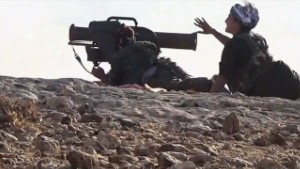ISIS: The street gang on steroids



 .
.
.
Photos: Syrian civil war in 2014
October 7, 2014 -- Updated 1117 GMT (1917 HKT)
![[File] This undated image shows ISIS fighters marching through Raqqa, Syria.](http://i2.cdn.turner.com/cnn/dam/assets/141007101559-isis-marching-story-top.jpg) |
| [File] This undated image shows ISIS fighters marching through Raqqa, Syria. |
Editor's note: James Densley is Assistant Professor of Criminal Justice at Metropolitan State University and the author of How Gangs Work: An Ethnography of Youth Violence. The opinions expressed in this commentary are his.
.
(CNN) -- As we well know, ISIS is recruiting angry young men as far afield as Minneapolis and London. The allure is much like the allure of a street gang -- in part, because ISIS looks an awful lot like a street gang.
Gangs have long been
understood as a collective response or "solution" to the strains
encountered by their respective members. For some youth, ISIS has become
the "solution." They are searching for the same protection and respect
that pull people into gangs. The difference is they are pushed by
feelings of marginalization, victimization, and vulnerability that stem
from the state's purported failure to protect Muslim interests.
.
"Fear leads to anger.
Anger leads to hate," Yoda once said. Anger also incites people to
action, lowers inhibitions, and fashions a desire for revenge.
There are legitimate
concerns about radicalization among existing gang members, because they
typically live out the same sociocultural and racial exclusion. Gang
members already hold more anti-authority attitudes than the rest of us.
Add to this the fact many of them go to prison each year, where they
come into contact with radicalized individuals and are subject to
influence, and the die has been cast.

Why is ISIS so wealthy?

Why is Kobani so important to ISIS?

Woman: I am proud to fight, kill ISIS
.
 .
..
Photos: Syrian civil war in 2014
For some gang members,
joining ISIS could even make real the mythologized gang life that made
gang membership originally so appealing. Real gang life -- where gang
members stand around in the rain waiting for something to happen, or
beg, borrow, and steal converted imitation firearms to make good on
their threats -- rarely lives up to the hype. Hence, many real gang
members still live at home with their mothers.
ISIS, by contrast, lives
up to the myth. ISIS is armed to the teeth with samurai swords and
Kalashnikovs. ISIS governs vast territories and shapes futures. ISIS,
flush with oil money, pays far better than minimum wage. ISIS is the
street gang on steroids.
Like many gangs, ISIS
grew out of another group (al Qaeda in Iraq,) evolved under charismatic
authority (Abu Bakr al-Baghdadi,) made some territorial gains (Syria and
Iraq,) changed its name a few times (IS, ISIS, ISIL,) and, eventually,
provoked a militarized response. In no way does this diminish the threat
ISIS poses. In gang colors, dissing a rival gang in a self-produced
YouTube video earns you five minutes of fame at best. Under ISIS's black
flag, beheading an aid worker guarantees life in 24-hour news in
perpetuity.
Having studied how gangs
work, I know first-hand some gang members are Islamists. Others are
attracted by the concept of terrorism. When gang members identify with
Islam, however, it is only on a superficial level. Above all, gang
members desire to be feared, thus, as in the Muslim Boys case in London, they strategically pose as jihadists and trade on powerful false perceptions about links to al Qaeda.
When gang members identify with Islam, however, it is only on a superficial level
James Densley
James Densley
Both groups also look
for all possible ways to enhance their reputation for violence because
violence has a property that other commodities lack: A reputation for
violence reduces the need for actual violence. To this end, just as
Internet-based forms of communication play a key role in the cultural
transmission of gang symbols and practice, technology also "advances the
motives and accelerates the methods of radicalization." Contrary to
popular belief, however, neither gangs nor terrorist groups formally
"recruit" via the Internet because "cheap talk" online cannot be
trusted.
Another thing gangs and
terrorists group share, is a deep tension between personnel needs and
infiltration risks. As a result, many are called to both groups but few
are chosen. Material incentives attract opportunists, so groups screen
for commitment. Illegal activity attracts law enforcement, so they also
screen for trustworthiness.
Terrorists recruit in
mosques for the same reasons gangs recruit in neighborhoods -- racial
and ethnic homogeneity and residential stability inherently promote
trust and, in the context of repeated interaction, reputations are
acquired and authenticated.
But radicalization, like
gang membership, lives on a spectrum. Radicalization, like gang
membership, is also a gradual process. It begins with personal
relationships. Lost men congregate at mosques, in neighborhoods, and
online, finding others like them. They build friendships around their
faith and its obligations or along the lines of shared identities and
social networks. Eventually, this "bunch of guys" comes to constitute a closed society that provides a sense of meaning that otherwise does not exist in the larger world.
Terror intervention,
like gang intervention, needs an emphasis not on the traditional "hot
spots" for radicalization, but rather the "hot people" most deeply
embedded in extremist networks. This is important. The old "hot spot"
approach to gang suppression alienated communities of color by
reinforcing the "us versus them" mentality that forced many people into
gangs in the first place.
Our current version of
"shock and awe" in response to ISIS risks prompting retaliation for the
same reason: It gives legitimacy to the extremist argument that the West
is complicit in the death of Muslims around the world.
As they say in the gang,
if you live by the gun, you die by the gun. To bring peace, both on the
streets and in Syria, underlying social and political grievances must
be addressed.
.

No comments:
Post a Comment